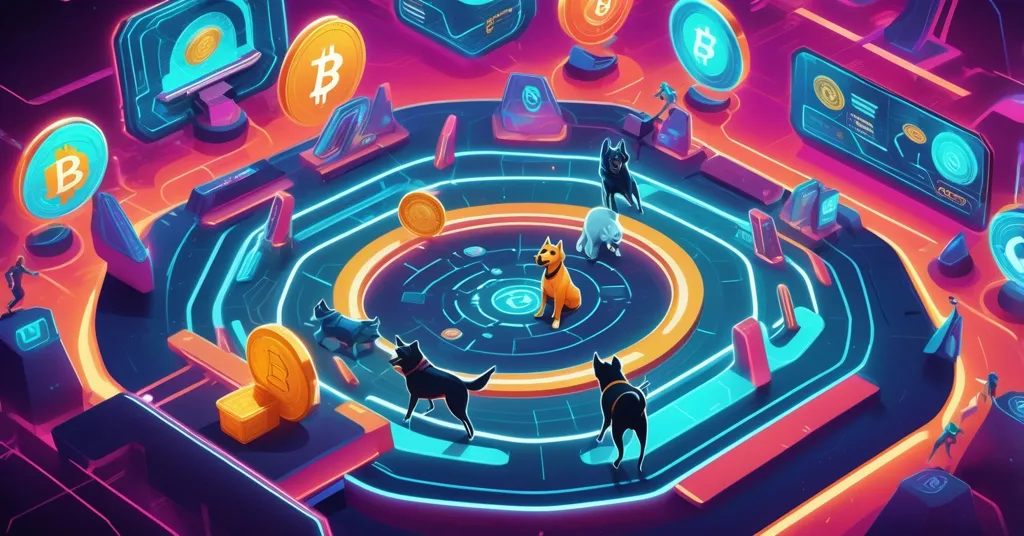4 Underrated Cryptos to Watch in July 2025: Can They Challenge Dogecoin?

4 Underrated Cryptocurrencies to Watch in July 2025: Can They Beat Dogecoin?
Could a tiny memecoin priced at just $0.0015 challenge Dogecoin’s billion-dollar empire? As the crypto market heats up in 2025, four under-the-radar projects are making noise with bold promises and tangible utility. Two of them are gunning straight for Dogecoin’s meme throne, while the others carve out powerful niches that could shift the blockchain game. Let’s dig into the details with a sharp eye and no tolerance for empty hype.
- Little Pepe (LILPEPE): A Layer-2 blockchain built for memecoins, aiming to outshine Dogecoin with real infrastructure.
- Sei (SEI): A DeFi powerhouse with institutional-grade appeal and explosive growth.
- TON: Harnessing Telegram’s massive user base for web3 and NFT dominance.
- SUI: A Layer-1 blockchain riding a price surge with developer momentum.
Why Altcoins Matter (Even to Bitcoin Maxis)
As a Bitcoin maximalist, I’ll always argue that BTC is the ultimate decentralized store of value—sound money for a broken financial system. But let’s be real: Bitcoin can’t (and shouldn’t) do everything. Altcoins, when they’re not just scams or vaporware, often fill gaps in scalability, usability, or niche innovation that BTC doesn’t touch. From powering meme-driven economies to onboarding millions via messaging apps, these projects can accelerate the broader mission of financial freedom and disruption. With that lens, let’s strip away the fluff and see if these underrated cryptos have what it takes to stand out in July 2025.
Little Pepe (LILPEPE): Memecoin Infrastructure with Bite
First up is Little Pepe, or LILPEPE, a project daring to take on Dogecoin not with tweets or memes, but with actual tech. Sitting at a presale price of $0.0015, LILPEPE has already raised $8.49 million of its $8.825 million target, selling 6.52 billion of 6.75 billion tokens—that’s nearly 97% complete, per project updates. The hype is real, but does the substance match?
LILPEPE claims to be the first Layer-2 blockchain dedicated solely to memecoins. For the unversed, a Layer-2 is a secondary network built on top of a main blockchain (likely Ethereum in this case, though unconfirmed) to process transactions faster and cheaper, reducing strain on the primary chain. LILPEPE’s pitch is niche but intriguing: dirt-cheap transactions, a launchpad for new memecoins, and built-in tools to stop sniper bots—those annoying automated programs that snap up tokens before regular folks can, ensuring a fairer shot for retail investors. This isn’t just another Shiba Inu knockoff; it’s an ecosystem play for the meme-obsessed crowd, with significant infrastructure potential.
Word on the street suggests listings on two major centralized exchanges are locked in, with rumors of a spot on the biggest platform out there (think Binance, though nothing’s confirmed). If true, the price could skyrocket post-presale. But hold the champagne—memecoins are a speculative minefield, and even utility can’t guarantee staying power. Dogecoin, for all its flaws, is a cultural beast fueled by nostalgia and Elon Musk’s whims. LILPEPE’s infrastructure might give it an edge over DOGE’s stagnant tech, but banking on “meme” as a core identity feels like a shaky bet. I’d rather stack sats than gamble on internet jokes, though I’ll admit, a memecoin launchpad could be a playground for wild innovation if it delivers. If you’re curious about the broader context of such tokens, check out details on memecoin history.
Counterpoint time: regulatory heat could crush a meme-focused project like this overnight. Governments aren’t exactly thrilled about speculative tokens, and a Layer-2 tied to memes might attract extra scrutiny. Plus, if the base chain (Ethereum or otherwise) faces congestion or fee spikes, LILPEPE’s promises could falter. Still, if it carves out a loyal community, could this be the spark that forces Dogecoin to evolve or die?
Sei (SEI): DeFi with Wall Street Cred
Institutional Appeal
Shifting gears from meme mania to serious finance, Sei is making a name for itself in decentralized finance (DeFi) with stats that can’t be ignored. Its Total Value Locked (TVL)—the amount of assets staked or locked in its protocols—has surged 821% year-over-year to over $670 million, as reported by ecosystem trackers. That’s not just retail FOMO; it’s a sign of big money eyeing Sei as a bridge between traditional finance and blockchain. For community perspectives, there’s an active discussion on Sei’s DeFi growth.
Real-World Asset Impact
The star of Sei’s show is USDY, a tokenized U.S. Treasury product backed by Mountain Protocol. Running as an ERC-20 token on Sei’s Ethereum Virtual Machine (EVM), USDY lets users tap into government-backed securities for DeFi plays like lending or yield farming—think earning interest by lending digital versions of Treasury bonds. It accounts for 32% of tokenized Treasury users and ranks fifth in TVL among real-world asset (RWA) tokens, trailing heavyweights like BlackRock’s BUIDL and Franklin Templeton’s BENJI. For context, tokenized RWAs are blockchain-based versions of real assets (stocks, bonds, property) that can be traded or used in DeFi apps, blending old-school finance with crypto’s borderless edge.
Sei’s growth isn’t meme-driven like Dogecoin; it’s grounded in utility that could legitimize blockchain for institutional players. Compared to competitors like Polygon or Avalanche, Sei’s TVL surge stands out, hinting at a unique appeal. But let’s not crown it yet—dethroning DOGE’s market cap is a pipe dream short-term, as sentiment often trumps fundamentals in crypto. My Bitcoin purist side scoffs at another altcoin claiming to “revolutionize finance,” yet Sei’s traction with real-world assets could push mainstream adoption faster than BTC’s slow, steady grind. Devil’s advocate here: institutional involvement might also mean more centralized control. Is Sei trading decentralization for dollars, and does that betray the ethos of this space?
TON: Telegram’s Web3 Gateway
Mass Adoption Potential
TON, short for The Open Network, brings a different angle, tapping into one of tech’s biggest user bases—Telegram, with hundreds of millions of active users worldwide, particularly strong in regions like Asia and Eastern Europe. In a jaw-dropping 10 days, TON saw over 1.1 million NFTs minted on its network. Non-fungible tokens, for the uninitiated, are unique digital assets often tied to art, gaming, or collectibles, and this volume screams engagement. TON isn’t chasing Dogecoin’s meme crown but building a practical web3 ecosystem.
Seamless Integration Risks
The secret sauce is Telegram integration, turning a chat app into a crypto hub. Imagine buying NFTs, trading tokens, or using in-app wallets without ever leaving your group chat—an onramp so smooth it could bring millions into blockchain without the usual tech headaches Bitcoin users face. This mass-market play is genius, especially for gaming or microtransactions. But pump the brakes—NFT hype has crashed before, and Telegram’s involvement doesn’t equal guaranteed success. Privacy hawks like me worry about tying wallets to a centralized messaging app. Could data leaks or government pressure turn this dream into a surveillance nightmare? And let’s be blunt: Telegram’s semi-centralized nature clashes with decentralization’s core. Still, TON’s potential to onboard “normies” is undeniable, and there are interesting insights on TON’s integration worth exploring—could this be the trojan horse web3 needs?
SUI: Layer-1 Momentum
Price Surge Breakdown
Rounding out our list is SUI, a Layer-1 blockchain—meaning it’s a foundational network like Bitcoin or Ethereum, hosting apps and protocols directly. SUI’s price has rocketed 47% in the last 30 days, breaking past $4 resistance. Traders are buzzing over a W-shaped reversal pattern, a chart signal that suggests a bottom has been hit and an uptrend is forming, backed by the Chaikin Money Flow (CMF) indicator showing more money flowing in than out. Next target? Analysts point to $4.20 resistance with solid support holding below, assuming 2025’s market doesn’t tank. For a deeper look at this trend, check out this analysis of SUI’s price surge.
Developer Traction
Beyond price, SUI’s real story is developer adoption. Specific dApps like decentralized exchanges and gaming platforms (though exact names aren’t public yet) are reportedly flocking to SUI for its scalability, drawing parallels to XRP’s bull run years ago. This isn’t about memes; it’s about building a usable platform. My skeptical side warns against chasing price pumps—Bitcoin’s value doesn’t ride on 30-day spikes—but SUI’s momentum feels less like hot air and more like genuine interest. Counterpoint: if a broader bear market or regulatory crackdown hits in 2025, SUI’s gains could evaporate. Does it have the staying power to rival established Layer-1s, let alone touch Dogecoin’s cultural grip?
Key Questions and Takeaways for Crypto Enthusiasts
- What makes Little Pepe (LILPEPE) a contender against Dogecoin in 2025?
LILPEPE’s Layer-2 blockchain for memecoins brings low-cost transactions and a launchpad for new tokens, offering utility Dogecoin lacks beyond viral hype. - How is Sei (SEI) gaining traction in the DeFi space?
With an 821% TVL jump to $670 million and tokenized U.S. Treasury product USDY, Sei attracts institutional investors by linking real-world assets to DeFi. - Why is TON positioned for mass web3 adoption?
TON leverages Telegram’s vast user base to drive NFT minting (over 1.1 million in 10 days) and seamless in-app crypto tools, making blockchain accessible to millions. - What’s behind SUI’s recent price surge and developer interest?
A 47% price jump past $4, backed by bullish chart patterns and growing dApp development, marks SUI as a promising Layer-1 for scalable blockchain solutions. - Can utility-driven altcoins overtake Dogecoin’s market dominance?
Dogecoin’s cultural hold is fierce, but sustained innovation from projects like LILPEPE and Sei could erode its edge if they prove real-world impact. - How do these altcoins fit into Bitcoin’s vision of decentralization?
While Bitcoin remains the ultimate decentralized money, altcoins like TON and SUI fill gaps—onboarding users and scaling tech—that speed up the financial revolution.
Risk Disclaimer: Navigate the Crypto Wild West
These projects show glimmers of promise, but crypto is still the wild west, packed with traps and snake oil salesmen. Presales can vanish, prices can crash, and hype can blind even savvy players. Do your own damn research before throwing money at anything—check whitepapers, track teams, and question everything. We’re here to inform, not shill, and adoption means nothing if you get burned.
Tying It Back to the Bigger Picture
Looking at LILPEPE, Sei, TON, and SUI, there’s a clear trend: the crypto space is shifting toward utility and adoption over pure speculation. Dogecoin might still wear the meme crown, but its lack of tech evolution leaves room for challengers with real value. Beyond individual projects, this wave of innovation ties directly to the mission of decentralization—disrupting broken systems, empowering users, and accelerating freedom through tech. Whether it’s memecoin playgrounds or institutional DeFi bridges, these experiments embody effective accelerationism, pushing boundaries even if half of them flop.
Macro conditions in 2025 could make or break these underdogs. If Bitcoin ETFs expand or global adoption spikes, capital could flood into alts like these. Conversely, rising interest rates or regulatory hammers could crush speculative plays. Personally, my BTC stack stays untouched—nothing beats its purity as sound money—but I’m keeping a close eye on these contenders. If they deliver even a fraction of their promises, 2025 could redefine what “money” and “value” mean in a decentralized world. Stay sharp, question the noise, and let’s see where this ride takes us.



